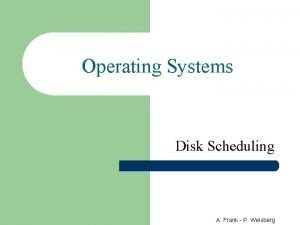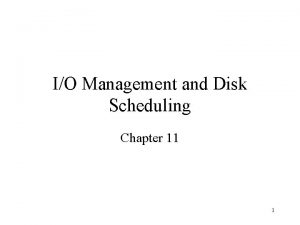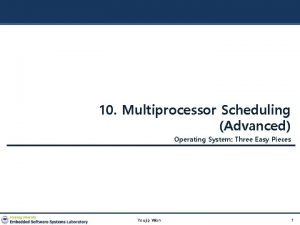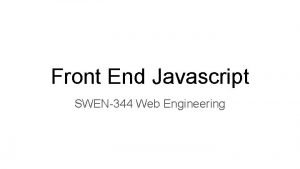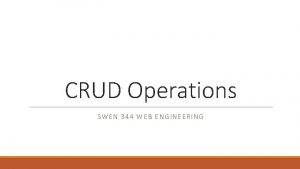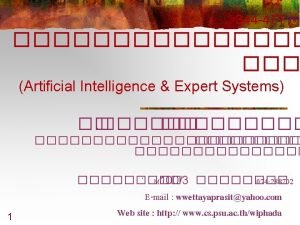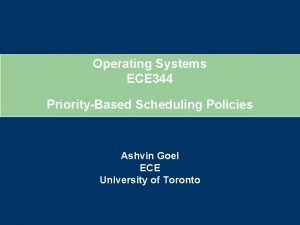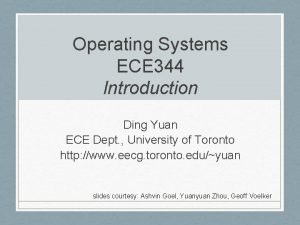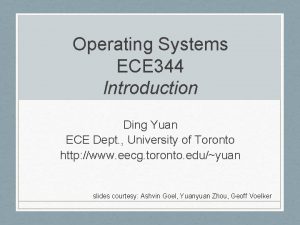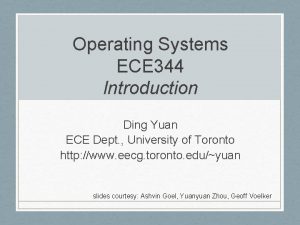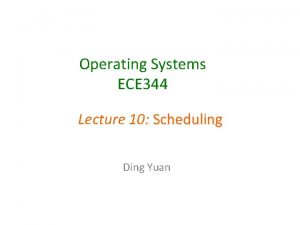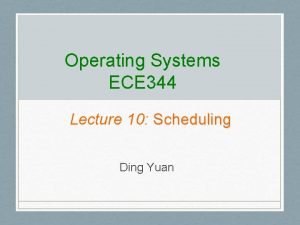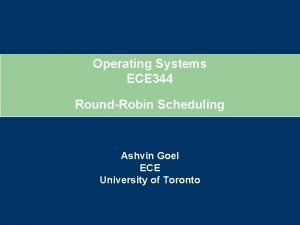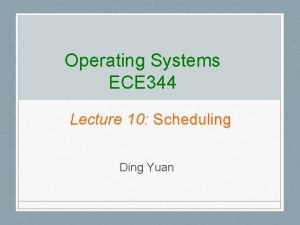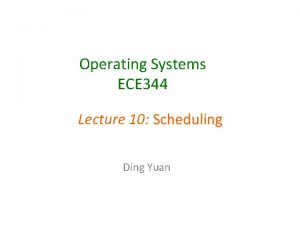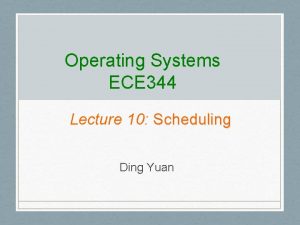Operating Systems ECE 344 Introduction to Scheduling Policies











- Slides: 11

Operating Systems ECE 344 Introduction to Scheduling Policies Ashvin Goel ECE University of Toronto

Overview q Scheduler overview q Scheduling goals Batch systems o Interactive systems o q Scheduling policies Batch scheduling policies o Interactive scheduling policies o 2

Overview of Thread Scheduler q A thread scheduler implements the threads abstraction o Allows running threads concurrently and in parallel q Scheduler runs when a thread calls threads API q When scheduler runs, it may run another thread_create thread_exit Running Ready Exited thread_yield thread_wakeup thread_sleep Blocked 3

Scheduler Mechanism q Scheduler runs another thread by Suspending current thread o Running another thread by resuming this thread o Thread switching impl. is called scheduling mechanism o q OS generally implements preemptive scheduling o Scheduler can suspend running thread at any time run thread_create current thread Ready thread_wakeup thread_exit Running thread_yield preemptive thread_yield Exited thread_sleep Blocked 4

Scheduling Policy q Several threads may be ready to run at any time q Which thread should the scheduler choose to run? q Choice depends on scheduling policy Chooses next thread to run, e. g. , highest priority o Decides whether and when to preempt this thread o Which thread torun run? current thread Ready Many threads are ready to run Running Exited preemptive thread_yield Blocked One scheduling mechanism, many scheduling policies! 5

Overview q Scheduler overview q Scheduling goals Batch systems o Interactive systems o q Scheduling policies Batch scheduling policies o Interactive scheduling policies o 6

CPU-Bound and IO-Bound Programs q Programs alternate between performing computation and IO, called CPU and IO bursts o A CPU-bound program has frequent CPU bursts § E. g. , matrix multiply o An IO-bound program has frequent IO bursts § E. g. , web server q When a program performs IO o q Program needs to wait for IO to finish, so CPU is not needed Scheduler runs another program to keep CPU busy o Improves CPU utilization 7

Common Computer Systems q Batch systems Long running, CPU-bound programs (jobs) o No interactive users, minimal time constraints o E. g. , report generation, big data processing o q Interactive (or general-purpose) systems Short running, IO-bound programs o Interactive users, response time constraints o E. g. , desktop, mobile environments o 8

Scheduling Goals q q Scheduler aims to improve different metrics for each type of system Batch systems CPU Utilization: % of time that CPU is busy (not idle) o Throughput: number of jobs that complete per unit time o Turnaround time: time needed from start to finish of job o turnaround time = processing time (running) + waiting time (not running) q Interactive systems o Response time: time between receiving request and producing response 9

Summary q A scheduling mechanism is the method by which a scheduler runs threads o q Involves switching threads A scheduling policy dictates Which thread is run next o When the thread stops running o q Scheduling policies aim to improve performance o Batch systems, with long-running, CPU bound jobs § Improve throughput and reduce waiting time o Interactive systems, with short-running IO bound jobs § Improve response time q Next lectures describe scheduling policies 10

Think Time q q Is there a difference between throughput and CPU utilization? If so, why? Why does improving (reducing) the response time reduce throughput as well? 11
